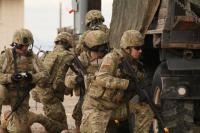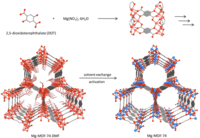-
Cotton candy machine inspires lighter bullet proof vests, and more

It is “boots on the ground” in this Harvard lab where the researchers are on a mission to protect U.S. troops on the battlefield. Researchersare developing next generation nanofibers at the Harvard Materials Research Science and Engineering Center (MRSEC). The researchers draw their inspiration from the cotton candy machine. They use their own version of that technology to spin a wide range of polymers, both natural and synthetic, into new fabrics and materials for military use.
-
-
Tougher steel could be used for body armor, shields for satellites

A team of engineers has developed and tested a type of steel with a record-breaking ability to withstand an impact without deforming permanently. The new steel alloy could be used in a wide range of applications, from drill bits, to body armor for soldiers, to meteor-resistant casings for satellites.
-
-
Protecting firefighters from harm
If there is anything common among the 1.1 million firefighters — both career and volunteer — serving in the United States, it is that at any moment, they may be required to put their lives on the line to protect people and property from disaster. But who helps protect these dedicated public servants from the on-the-job dangers they face?
-
-
Fibers from natural fats make bulletproof vests stronger and greener
Bulletproof vests and other super-strong materials could soon become even tougher and more environmentally friendly at the same time with the help of extra firm, or “al dente,” fibers. These materials, which are powerful enough to stop speeding bullets, can also be used for many other tasks that require strength.
-
-
Wireless technology enables advanced up protective clothing
Combining the latest advances in sensor and wireless technology with comfortable protective clothing has opened up new partnership possibilities across a range of sectors. Numerous end users stand to benefit from the inclusion of smart technology in protective clothing. One French start-up has pioneered intelligent active protection systems for ski racers. Further advances may see the use of advanced protective clothing by soldiers and first responders.
-
-
Clothing that guards against chemical warfare agents
Recent reports of chemical weapons attacks in the Middle East underscore the need for new ways to guard against their toxic effects. Scientists report that a new hydrogel coating that neutralizes both mustard gas and nerve agent VX. It could someday be applied to materials such as clothing and paint.
-
-
Critics question the need to equip EMS personnel with protective gear
The longer a wounded victim on a scene of a crime must wait for medical treatment, the lower the likelihood of that victim’s survival. Medical personal, however, must wait until the police secure the scene before they are allowed to approach the wounded. More and more EMS units now carry Kevlar helmets and bullet-proof vests with them so they can rush to help the wounded even if the crime scene is not completely secured. Some residents of San Leandro, California say, however, that the decision by the city council to purchase an armored vehicle and convert it into an armored ambulance is going too far.
-
-
Boxfish shell inspires new materials for body armor
The boxfish’s unique armor draws its strength from hexagon-shaped scales and the connections between them, engineers have found. The engineers say that the structure of the boxfish could serve as inspiration for body armor, robots, and even flexible electronics.
-
-
Improved body armor saves money
The efforts of researchers have now culminated in the first deliveries of more than 148,000 Generation III Improved Outer Tactical Vest, or Gen III IOTV, body armor conversion kits, acquired at approximately half the cost of procuring new systems — $791 versus $413. Best practices from government and industry, soldier feedback, and creative thinking allowed the team to chart a path to upgrade older versions of the IOTV at half the cost of new Gen IIIs.
-
-
New foam technology to lead to better protective equipment
Foam. We wear it. We sit on it. We sleep on it. We even use it to protect ourselves. Whether it is a football helmet, hospital bed, knee pad, or body armor, the foam it contains plays a critical role in making that product both comfortable and safe. Can that foam, however, be transformed into something significantly better, safer and more comfortable? An FSU researcher has developed a brand new, high-performing auxetic foam with a unique ability to get thicker, rather than thinner, when stretched. In practical terms, this counter-intuitive behavior, totally opposite to that of conventional foam, leads to many enhanced materials properties including a better and more comfortable fit that adjusts on the fly.
-
-
Improved structure firefighting glove commercially available
When responding to structural fires, firefighters wear protective gloves known as “structure gloves” to shield their hands from burns and other injuries. Because structure gloves can be bulky and limit dexterity, firefighters often need to remove the gloves to complete routine tasks, such as handling operating tools or using communications equipment. Without gloves, firefighters’ hands are at a higher risk of injury. DHS S&T partnered with two companies to construct a new, improved structure glove that will provide the full range of protection firefighters need. This next-generation glove provides firefighters with enhanced dexterity, water repellency and fire resistance. The glove is now commercially available.
-
-
Soldiers, astronauts to be protected by tough, flexible new material
A team of researchers has developed a revolutionary material that has superior anti-penetration properties while remaining flexible. Inspired by the way nature designed fish scales, the material could be used to make bulletproof clothing for the military and space suits that are impervious to micro-meteorites and radiation when astronauts embark on spacewalks. The material emulates the skins of many species of fish — skins which are flexible, but which also protect the fish by hard scales.
-
-
Redesigning wild-land fire fighter uniforms
The most common cause of injuries to wild-land firefighters is not burns. When leaders at the California Department of Forestry and Fire Protection (CAL FIRE) noticed their wild-land firefighters were experiencing more heat stress injuries — like heat exhaustion and heat stroke — than burn injuries, they wanted to know why and how to prevent them. They soon realized their uniforms were part of the problem. Working with a team at the University of California, Davis, they developed technical and design specifications for a new uniform aimed at increasing the comfort and breathability while maintaining the current level of protection against flames. In 2011, CAL FIRE approached the Department of Homeland Security Science and Technology Directorate’s (S&T) First Responders Group (FRG) requesting assistance in developing prototype garments.
-
-
Improved protective suit for Ebola caregivers
An advanced protective suit for health care workers who treat Ebola patients, devised by a Johns Hopkins University team, is one of the first five awardees in a federal funding contest aimed at quickly devising new tools to combat the deadly disease. The JHU prototype is designed to do a better job than current garments in keeping health care workers from coming in contact with Ebola patients’ contagious body fluids, both during treatment and while removing a soiled suit. In addition, it is expected to keep the wearer cooler — an important benefit in hot, humid regions such as West Africa.
-
-
New gas mask filtration materials show promise

Scientists are examining the possibility of metal-organic framework compounds (MOFs) — porous crystalline materials which are made up metal ions and bridged with organics — as a possible evolution in gas mask filtration technology. Thought MOFs may still be a way from real-world application, the impact that they might have on respiration technologies could be significant.
-
- All
- Regional
- Water
- Biometrics
- Borders/Immig
- Business
- Cybersecurity
- Detection
- Disasters
- Government
- Infrastructure
- International
- Public health
- Public Safety
- Communication interoperabillity
- Emergency services
- Emergency medical services
- Fire
- First response
- IEDs
- Law Enforcement
- Law Enforcement Technology
- Military technology
- Nonlethal weapons
- Nuclear weapons
- Personal protection equipment
- Police
- Notification /alert systems
- Situational awareness
- Weapons systems
- Sci-Tech
- Sector Reports
- Surveillance
- Transportation
Advertising & Marketing: advertise@newswirepubs.com
Editorial: editor@newswirepubs.com
General: info@newswirepubs.com
2010-2011 © News Wire Publications, LLC News Wire Publications, LLC
220 Old Country Road | Suite 200 | Mineola | New York | 11501
Permissions and Policies
Editorial: editor@newswirepubs.com
General: info@newswirepubs.com
2010-2011 © News Wire Publications, LLC News Wire Publications, LLC
220 Old Country Road | Suite 200 | Mineola | New York | 11501
Permissions and Policies
